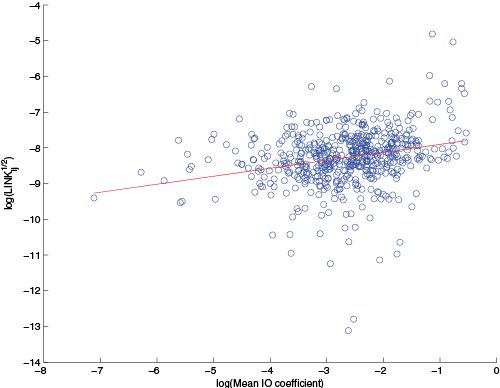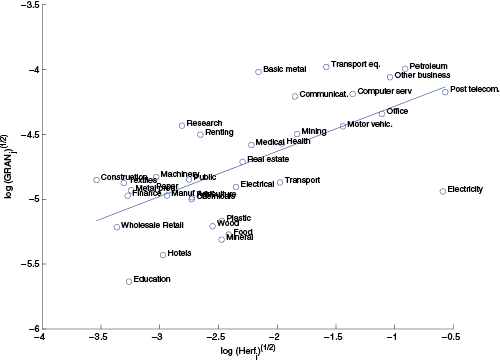Practical discussions of macroeconomic fluctuations are often couched in terms of the impact of individual firms on aggregate GDP. For instance, according to JPMorgan, sales of Apple’s iPhone 5 could add as much as half a percentage point to US 4th quarter GDP growth this year (CNBC 2012). In France, the recent poor performance of Renault and Peugeot is expected to induce a domino effect across the production chain. Since it is believed that each job lost in Renault leads to the disappearance of two or three suppliers of automobile parts, an adverse shock to this car manufacturer could drag down aggregate growth in the French economy (Le Point 2012). These two examples pertain to very large economies, but in smaller countries the contribution of individual large firms to aggregate fluctuations is likely to be even more noticeable (di Giovanni and Levchenko 2012).
The role of firms in the business cycle
By contrast, the role of firms in the business cycle has received comparatively less attention in the literature; the majority of research in macroeconomics relies on aggregate (economy-wide) shocks as a driver of aggregate fluctuations. A prominent exception is a recent contribution by Gabaix (2011), which argues that because the firm size distribution is extremely fat-tailed – the economy is ‘granular’. This means that idiosyncratic shocks to individual (and large) firms will not average out and instead lead to aggregate fluctuations. Acemoglu et al. (2012) have developed a network model in which idiosyncratic shocks to a single firm or sector can have sizeable aggregate effects if it is strongly interconnected with other firms/sectors in the economy, regardless of the size distribution. However, there is currently little empirical evidence to complement these theoretical studies1.
Empirical approach
In our research, we provide a forensic account of the contribution of individual firms to aggregate fluctuations using a novel database covering the universe of French firms’ domestic sales and destination-specific exports for the period 1990–2007 (di Giovanni, Levchenko, and Méjean 2012). We develop an empirical strategy that decomposes the growth of a firm’s rate of sales of to a single destination market into
- A macroeconomic shock, defined as the component common to all firms
- A sectoral shock, defined as the component common to all firms in a particular sector
- A firm-level shock.
The procedure yields estimates of the time series of the macroeconomic, sectoral, and firm-specific shocks for each destination served by each firm. We then decompose aggregate volatility in the economy into the contributions of macroeconomic/sectoral and firm-specific shocks, and use our estimates to assess whether microeconomic shocks have an impact on aggregate volatility.
Firm-specific contributions
Our main finding is that firm-specific components do contribute substantially to aggregate fluctuations. Their contribution is roughly similar in magnitude to the combined effect of all sectoral and macroeconomic shocks. We then evaluate two explanations for the positive overall contribution of firm-specific shocks. The first – from Gabaix (2011) – is that firm-specific idiosyncratic volatility does not average out because of the presence of very large firms. We refer to this as the ‘granularity’ hypothesis. The second – from Acemoglu et al. (2012) – is that idiosyncratic shocks contribute to aggregate fluctuations because input-output linkages generate comvement between firms. We refer to this as the “linkages” hypothesis. The overall contribution of firm-specific shocks to aggregate volatility can be decomposed additively into two terms that capture these two mechanisms. Though both channels matter quantitatively, about two-thirds of the contribution of firm-specific shocks to the aggregate variance is accounted for by the 'linkages' effect – the covariances of the firm-specific components of the growth rate of sales.
Explaining ‘granularity’ and ‘linkages’
We then exploit cross-sectoral heterogeneity to provide further evidence on the ‘granularity’ and ‘linkages’ mechanisms. We compare the covariances of the firm-specific shocks aggregated at the sector level to a measure of sectoral linkages taken from the Input-Output Tables. As shown in Figure 1, sectors with stronger input-output linkages tend to exhibit significantly greater correlation of firm-specific shocks. This is direct evidence for the linkages hypothesis. We also relate each sector’s contribution to aggregate volatility to the ‘granularity’ of the sector.
Figure 1. Sectoral input-output linkages and covariance of firm-specific shocks
Gabaix (2011) shows that granular fluctuations in the economy will be more pronounced the larger is the Herfindahl index of firm sales – a common measure of concentration. Confirming this result, Figure 2 shows that industries that are more concentrated than the average sector contribute more significantly to aggregate volatility, whereas the contribution of less concentrated sectors is comparatively smaller. In summary, we find direct corroboration in the data for the mechanisms behind both the ‘granularity’ and the ‘linkages’ hypotheses. Sectors that are populated by firms that are more interconnected with the rest of the economy; and more concentrated contribute a disproportionate share of aggregate volatility relative to what we would expect in a ‘symmetric’ economy.
Figure 2. Sector’s concentration (Herfindahl Index) and sector’s contribution to aggregate volatility
The rising importance of large firms
Looking forward, both the recent theoretical contributions and our findings are informative given the significant and rising importance of large firms in overall economic activity. Trade integration has the potential to make the largest firms even larger (di Giovanni and Levchenko, 2012). Likewise, consolidation across industries -- for instance via mergers and acquisitions -- also leads to a fatter tail in the firm-size distribution. These two structural changes amplify granular fluctuations, making business cycles more sensitive to individual firms’ shocks. At the same time, the boundaries of the firm are changing and production processes are becoming more fragmented. Some activities that used to be internal to the firm are now outsourced. This fragmentation takes place both within and across borders, and within and across sectors, adding further scope for shocks to individual firms to propagate throughout the economy as well as across countries.
Finally, one only needs to look at the most recent global crisis to note the importance of the transmission of shocks between sectors and firms. A shock that started in the financial sector spread rapidly to the rest of the economy. The dramatic fall in international trade highlighted how the international fragmentation of production processes was a powerful amplification mechanism of shocks.
References
Acemoglu, Daron, Vasco M Carvalho, Asuman Ozdaglar, and Alireza Tahbaz-Salehi (2012), “The Network Origins of Aggregate Fluctuations”, forthcoming, Econometrica, May.
Carvalho, Vasco M and Xavier Gabaix (2010), “The Great Diversification and its Undoing”, mimeo, CREi, Universitat Pompeu Fabra and NYU, October.
CNBC.com (2012), “Apple's iPhone 5 Sales Could Add Half a Point to GDP”, 10 September.
di Giovanni, Julian and Andrei A Levchenko (2012), “Country Size, International Trade, and Aggregate Fluctuations in Granular Economies”, forthcoming, Journal of Political Economy, October.
di Giovanni, Julian, Andrei A Levchenko, and Isabelle Méjean (2012), “Firms, Destinations, and Aggregate Fluctuations”, 2012, CEPR Discussion Paper, 9168.
Dupor, Bill (1999), “Aggregation and Irrelevance in Multi-sector Models”, Journal of Monetary Economics, 43(2), 391–409.
Foerster, Andrew T, Pierre-Daniel G Sarte, and Mark W Watson (2011), “Sectoral vs. Aggregate Shocks: A Structural Factor Analysis of Industrial Production”, Journal of Political Economy, 119 (1), 1–38.
Gabaix, Xavier (2011), “The Granular Origins of Aggregate Fluctuations,” Econometrica, 79 (3), 733–772.
Horvath, Michael (1998), “Cyclicality and Sectoral Linkages: Aggregate Fluctuations from Independent Sectoral Shocks,” Review of Economic Dynamics, 1(4), 781–808.
Horvath, Michael (2000), “Sectoral Shocks and Aggregate Fluctuations,” Journal of Monetary Economics, 45(1), 69–106.
Le Point (2012), “Équipementiers et automobile: les comptes ne sont pas bons”, 23 July.
Stockman, Alan C (1988) “Sectoral and National Aggregate Disturbances to Industrial Output in Seven European Countries”, Journal of Monetary Economics, 21, 387–409.
1 A closely related and older tradition in macroeconomics, starting with the seminal work of Long and Plosser (1983), explores the role of sectoral shocks in generating aggregate fluctuations (cf. Stockman 1988, Horvath 1998, 2000, Dupor 1999, Foerster et al. 2011, Carvalho and Gabaix 2010).








